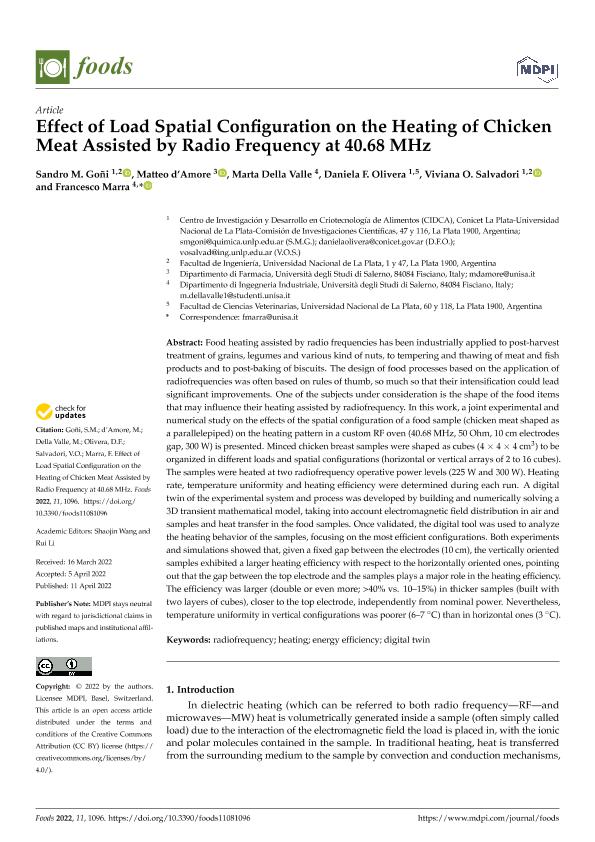Artículo
Effect of load spatial configuration on the heating of chicken meat assisted by radio frequency at 40.68 MHz
Goñi, Sandro Mauricio ; d'Amore, Mateo; Della Valle, Marta; Olivera, Daniela Flavia
; d'Amore, Mateo; Della Valle, Marta; Olivera, Daniela Flavia ; Salvadori, Viviana Olga
; Salvadori, Viviana Olga ; Marra, Francesco
; Marra, Francesco
 ; d'Amore, Mateo; Della Valle, Marta; Olivera, Daniela Flavia
; d'Amore, Mateo; Della Valle, Marta; Olivera, Daniela Flavia ; Salvadori, Viviana Olga
; Salvadori, Viviana Olga ; Marra, Francesco
; Marra, Francesco
Fecha de publicación:
04/2022
Editorial:
Multidisciplinary Digital Publishing Institute
Revista:
Foods
ISSN:
2304-8158
Idioma:
Inglés
Tipo de recurso:
Artículo publicado
Clasificación temática:
Resumen
Food heating assisted by radio frequencies has been industrially applied to post-harvest treat-ment of grains, legumes and various kind of nuts, to tempering and thawing of meat and fish products and to post-baking of biscuits. The design of food processes based on the application of radiofrequencies was often based on rules of thumb, so much so that their intensification could lead significant improvements. One of the subjects under consideration is the shape of the food items that may influence their heating assisted by radiofrequency. In this work, a joint experi-mental and numerical study on the effects of the spatial configuration of a food sample (chicken meat shaped as a parallelepiped) on the heating pattern in a custom RF oven (40.68 MHz, 50 Ohm, 10 cm electrodes gap, 300 W) is presented. Minced chicken breast samples were shaped as cubes (4 × 4 × 4 cm3) to be organized in different loads and spatial configurations (horizontal or vertical arrays of 2 to 16 cubes). The samples were heated at two radiofrequency operative pow-er levels (225 W and 300 W). Heating rate, temperature uniformity and heating efficiency were determined during each run. A digital twin of the experimental system and process was devel-oped by building and numerically solving a 3D transient mathematical model, taking into ac-count electromagnetic field distribution in air and samples and heat transfer in the food samples. Once validated, the digital tool was used to analyze the heating behavior of the samples, focus-ing on the most efficient configurations. Both experiments and simulations showed that, given a fixed gap between the electrodes (10 cm), the vertically oriented samples exhibited a larger heat-ing efficiency with respect to the horizontally oriented ones, pointing out that the gap between the top electrode and the samples plays a major role in the heating efficiency. The efficiency was larger (double or even more; >40% vs. 10?15%) in thicker samples (built with two layers of cu-bes), closer to the top electrode, independently from nominal power. Nevertheless, temperature uniformity in vertical configurations was poorer (6?7 °C) than in horizontal ones (3 °C).
Palabras clave:
RADIOFREQUENCY
,
HEATING
,
EFFICIENCY
,
DIGITAL TWIN
Archivos asociados
Licencia
Identificadores
Colecciones
Articulos(CIDCA)
Articulos de CENTRO DE INV EN CRIOTECNOLOGIA DE ALIMENTOS (I)
Articulos de CENTRO DE INV EN CRIOTECNOLOGIA DE ALIMENTOS (I)
Citación
Goñi, Sandro Mauricio; d'Amore, Mateo; Della Valle, Marta; Olivera, Daniela Flavia; Salvadori, Viviana Olga; et al.; Effect of load spatial configuration on the heating of chicken meat assisted by radio frequency at 40.68 MHz; Multidisciplinary Digital Publishing Institute; Foods; 11; 1096; 4-2022; 1-18
Compartir
Altmétricas



